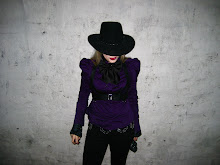 Although butoh has been defined as an art form that cannot be defined, there are salient elements that signal the genre's existence. This dance/movement that originated in post-war Japan is not rooted purely in escapist fantasy, nor is it confined to unadorned realism. It is the clash and interplay between these two states that makes butoh so intriguing, and nothing was more evident at Japan Society's Friday performance of Ame to Ame (Candy and Rain), a duet performed by San Francisco's Shinichi Iova-Koga and Berlin's Yuko Kaseki.
Although butoh has been defined as an art form that cannot be defined, there are salient elements that signal the genre's existence. This dance/movement that originated in post-war Japan is not rooted purely in escapist fantasy, nor is it confined to unadorned realism. It is the clash and interplay between these two states that makes butoh so intriguing, and nothing was more evident at Japan Society's Friday performance of Ame to Ame (Candy and Rain), a duet performed by San Francisco's Shinichi Iova-Koga and Berlin's Yuko Kaseki.Directed and designed by Marc Ates, artful moments in everyday movements were juxtaposed with stylized choreography that was naturalized by its injection into mundane circumstances. Playful and manic, contemplative and comatose, with plenty of grotesque grimaces and comic mugging to create meta-narratives throughout, Iova-Koga and Kaseki always exhibited complete control. Even when projecting rambunctious, sloppy revelry, their focus was so intense it radiated energy from the stage.
Ame to Ame concurrently drew attention to individual movements, the storyline, and the props onstage. The physicality of the performers was an obvious essential to the piece, whether in the stuttering minutiae of each muscle undulating in a particularly supersonic section, or the languid, drunken Noh-slow movements that stretched time out like cotton candy.
Equally important was each individual dancer's persona and his/her interactions with the other, which created a strange romance that seemed more narcissistic than sweet at times. Repeated moments where Iova-Koga and Kaseki hugged themselves and the air around them (or danced alone while voyeuristically viewing the other) created an excellent juxtaposition of expression for this so-called 'love story'.
Last but not least was the moving reverence for inanimate objects exhibited by the two. The way the duo play-fought over a small white desk, always picking it up with the greatest of care before stealing it away from the other transformed the prop into a third character onstage. Another charming bit was when Kaseki danced with Iova-Koga's white jacket, clutching its folds lovingly before unfurling it across his waiting back and shoulders with a James-Brown-cape-finale flair.
The music was a background element and at times shared equal performance space with the duo, ranging from ambient soundscapes to spoken word and art damaged folk rock tunes that were curious and delightful. The lighting was also excellent, and perfectly matched with the movements to punctuate and pronounce certain sections.
While there were moments that invited more attention than others, the piece as a whole was riveting. Ame to Ame combined so many styles, emotions, and forms of expression that it would be impossible to enumerate them all. Nor would that be necessary, for the part of butoh that is so anathema to definition is the part which allows the art form to retain its arcane aura, making it continually ripe for exploration even half a century after its enshrouded inception.








2 comments:
Thanks for the review. I would have *loved* to see this. I'm glad you caught it.
thanks for the friendly & loving eye... not only but a matter of position: 'i did like the theatrical apect of the performance...' was another critic.
ates
Post a Comment